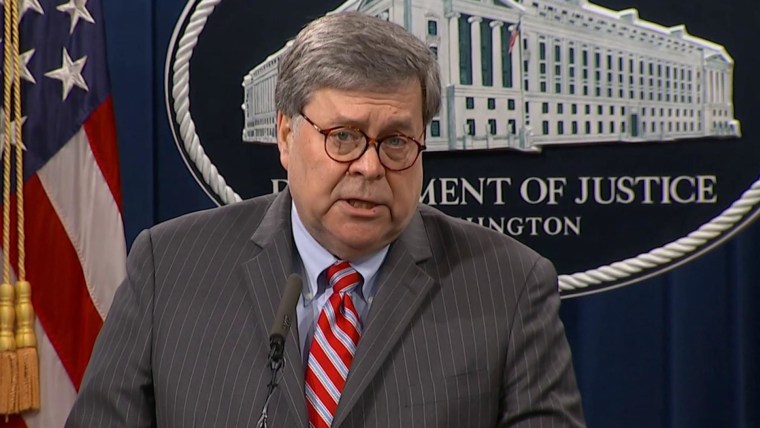After months of claiming that Apple’s privacy protections had stalled its investigation, the Justice Department said Monday that it had accessed a suspected terrorist’s iPhone with no help from the company.
In a news conference Monday, Attorney General William Barr said that Mohammed Alshamrani, the Saudi Air Force officer accused of killing three classmates and wounding eight at Pensacola Air Station in Florida on Dec. 6, was affiliated with al Qaeda. Alshamrani shot one of his two iPhones during the attack, which the FBI wanted to examine for possible ties to terror groups. Apple has consistently held a position that it won’t re-engineer its phones for law enforcement.
“Apple’s decision has dangerous consequences for public safety and national security and is, in my judgement, unacceptable” Barr said Monday.
The announcement echoed previous standoffs between Apple and the DOJ that have all ended the same way — with law enforcement finding its own way in to unlocking a phone despite claiming it needed Apple’s help.
Barr had used the case to renew a decades-old tug-of-war between the U.S. justice system and the tech industry over whether private companies should be able to provide encrypted methods of communication so secure that even the companies that make the hardware and software cannot access it.
The FBI was able to eventually access Alshamrani’s phone not by an unprecedented technical feat, but rather by “an automated passcode guesser,” according to a person familiar with the situation who spoke on the condition of anonymity because the person was not authorized to speak publicly on the matter.
Byers Market Newsletter
Get breaking news and insider analysis on the rapidly changing world of media and technology right to your inbox.
Barr — and many others in law enforcement — have consistently slammed Apple over its refusal to undermine its products for law enforcement. At a cybersecurity and law enforcement news conference in 2019, Barr said that it was “only a matter of time before a sensational case crystalizes the issue for the public.”
In January, Barr indicated that the Alshamrani case “perfectly illustrates why it is critical that investigators be able to get access to digital evidence once they have obtained a court order based on probable cause.”
“We have asked Apple for their help in unlocking the shooter’s iPhones. So far Apple has not given us any substantive assistance,” he said at a news conference.
But security experts have resoundingly insisted throughout the years that deliberately creating a so-called backdoor into an encrypted device inherently creates a path for governments and criminals to get in.
Riana Pfefferkorn, associate director of surveillance and cybersecurity at the Stanford Center for Internet and Society, noted that the FBI was eventually able to find a way into Alshamrani’s phone without Apple’s help.
That “further draws into question the necessity of requiring Apple to build an access mechanism for law enforcement into their phones,” Pfefferkorn said. “However, it is unlikely that the government will wholly let up on calling for such a mandate.”
Despite the public disagreement between the Justice Department and the tech industry, the two have long found themselves in an uneasy grey area. Even if Apple doesn’t provide a way for law enforcement to bypass its encryption, investigators can turn to third-party companies that specialize in exploiting software vulnerabilities to effectively access what’s on a protected device.
It is unclear precisely what model or models of iPhone Alshamrani had. If they were older models, it appears likely that they would have been easier to break into. Generally speaking, older software, even on an iPhone, is less secure by definition.
Even as far back as January, federal investigators told Apple that they were using automated software to “guess” at the passcodes to the phones, a process known as “brute force.”
After a fatal shooting in San Bernardino, California, in December 2015, the Department of Justice two months later sought an order from a federal magistrate judge asking her to order Apple to create a customized version of its iPhone software that would enable the brute force method to work. At the time, the government expressed concern that one of the iPhones belonging to a suspect in the San Bernardino shooting was set to auto-delete itself after 10 password attempts. Any attempt to retrieve evidence would almost certainly fail.
This potential triggering of the auto-delete function does not appear to have been a concern in the Pensacola case, however.
FBI Director Christopher Wray echoed Barr’s comments against Apple, saying the government had “received effectively no help” from the company.
While Apple declined to comment for this article, the company previously characterized the issue much differently.
“The FBI only notified us on January 6th that they needed additional assistance — a month after the attack occurred. Only then did we learn about the existence of a second iPhone associated with the investigation and the FBI’s inability to access either iPhone,” an Apple spokesperson said in a statement in January.
“It was not until January 8th that we received a subpoena for information related to the second iPhone, which we responded to within hours. Early outreach is critical to accessing information and finding additional options,” the spokesperson said.













